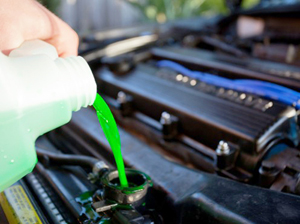 “Antifreeze” (also known as “coolant”) is basically a mixture of water and ethylene glycol which serves to lower the freezing temperature of the water while also raising its boiling point. Antifreeze has been used in “water cooled” vehicles since the dawn of the automobile because of its effectiveness. As opposed to “air cooled” vehicles which rely only on a fan blowing air on the engine block, water cooled vehicles feature an entire system of hoses, channels, a water pump, thermostat, heater core, radiator, and more.
“Antifreeze” (also known as “coolant”) is basically a mixture of water and ethylene glycol which serves to lower the freezing temperature of the water while also raising its boiling point. Antifreeze has been used in “water cooled” vehicles since the dawn of the automobile because of its effectiveness. As opposed to “air cooled” vehicles which rely only on a fan blowing air on the engine block, water cooled vehicles feature an entire system of hoses, channels, a water pump, thermostat, heater core, radiator, and more.
Within this system, the antifreeze travels in a circular path through the engine block where it removes heat generated by combustion, through the vehicle’s heater core (supplies heat to the vehicle’s interior), through the radiator (disperses the heat away into the air), and finally through the water pump which produces pressure necessary to keep the antifreeze moving.
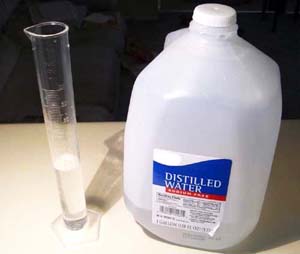
Avoid adding tap water and filtered water to your cooling system because they are full of minerals such as calcium and magnesium which leave deposits.
With nothing more than the right corrosion inhibitors added, water alone would cool an automotive engine just fine – until outside circumstances caused it to freeze or boil over. Antifreeze was developed and perfected to prevent those disasters when mixed with water, and it contains additives that prevent corrosion of metal components it comes in contact with. In this article, we’ll take a look at the different types and colors of antifreeze on the market today, the characteristics of each, and how pure antifreeze should be mixed with water based on various climates.
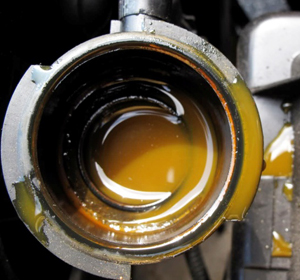
Antifreeze that’s become brown or rusty in color indicates inhibitors have broken down to the point where rust and scale buildup can no longer be controlled.
Like any fluid that goes into a vehicle, antifreeze has a lifespan and it has a point at which it begins to degrade. But it’s not the ethylene glycol itself that wears out, it’s the corrosion inhibitor ingredients added to it which get consumed. These inhibitors prevent rust from forming on metal parts such as water pumps and engine blocks, and get used up at various rates depending on chemical makeup. Antifreeze that’s become brown or rusty in color indicates inhibitors have broken down to the point where rust and scale buildup can no longer be controlled. If you’re interested in replacing your old antifreeze, you’ll find our article on servicing your cooling system helpful.
ADDING WATER TO ANTIFREEZE
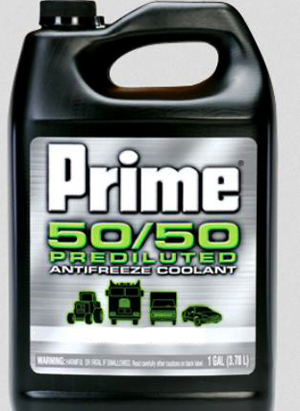
Antifreeze that’s been pre-mixed with water will always state that fact on the label clearly. Pre-mixed antifreeze will always use distilled water and be a 50/50 percentage blend.
Unless antifreeze containers state on their label that they’ve already been pre-mixed 50/50 with water during the manufacturing process, you’re getting “full strength” antifreeze and must dilute it with water yourself. Typically, full strength antifreeze provides more value when purchased – even after the cost of distilled water is factored in. If you prefer the convenience of not having to worry about mixing things accurately yourself, 50/50 mix is the way to go.
No matter which type or color your antifreeze is, it will transfer heat away most efficiently when blended with the proper amount of water – a mixture percentage based on the lowest temperatures typically seen in your climate. Most regions are best suited to a 50/50 water-antifreeze mixture that provides protection from a low of -34°F to a high of 265°F. In addition, maintaining proper freeze point protection ensures corrosion inhibitors remain at intended levels.
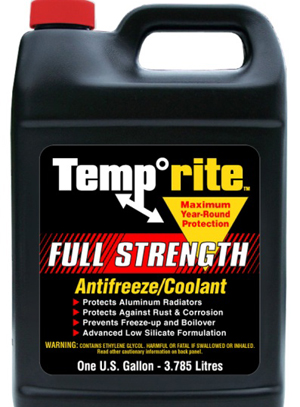
“Full-strength” or “Concentrated” antifreeze has not been pre-diluted with water, so you must do so before using it.
It’s interesting to note that pure antifreeze alone will not perform the tasks of protecting your vehicle’s cooling system any better than water would by itself. In fact, it pure antifreeze will freeze at about the same temperature water does. Plus, antifreeze by itself can’t carry heat away with the same effectiveness as water. In the coldest climates, the most effective mixture against freeze-up will consist of 60-70% antifreeze (with the rest being water) – not 100%.
Distilled Water is Always Best
Tap water and even filtered water are full of minerals such as calcium and magnesium which leave deposits inside the entire cooling system – particularly around parts of the engine that reach high temperatures. So no matter what type of antifreeze your vehicle requires, use only distilled water when formulating your mixture. Because distilled water has been boiled and re-condensed, mineral deposits and other impurities have been left behind. And since it’s available at any supermarket or auto parts store, excuses for not using distilled water are limited.
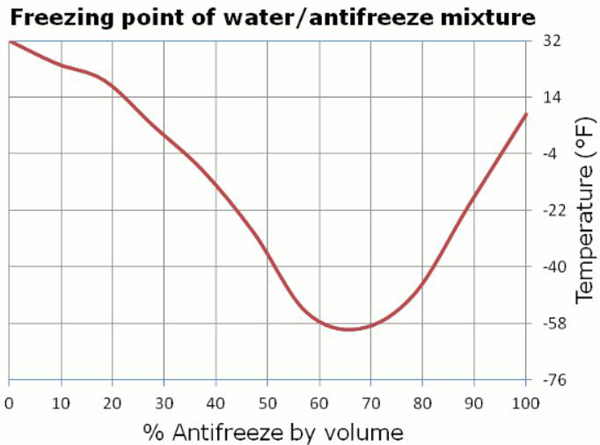
: This chart shows the range of temperatures at which antifreeze of various dilutions will freeze solid. In the coldest climates, the most effective mixture against freeze-up will consist of 60-70% antifreeze and the rest water.
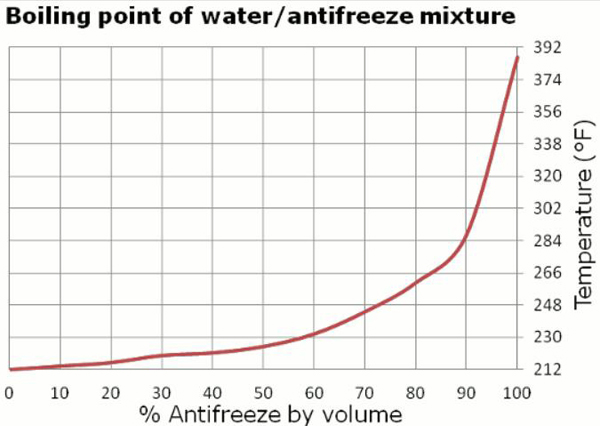
As you can see in this chart, the boiling point of an antifreeze/water mixture increases linearly depending on the percentage of antifreeze added.
THE HEALTH OF YOUR ENTIRE COOLING SYSTEM CAN SUFFER IF THE COOLANT LEVEL IS LOW
Antifreeze is much more corrosive when it’s in the form of hot, steaming vapors instead of a normal liquid state. When a cooling system is constantly low, these vapors fill the extra available space – creating an environment that’s extremely corrosive to metal components and seals inside the engine. Plus, metal components that become exposed because there’s not enough antifreeze quickly form corrosion – something that transforms clean, effective coolant into sludgy, dirty coolant. And, of course, a cooling system cannot transfer heat properly when there isn’t enough antifreeze to do it. The engineers that created your vehicle designed it to operate full of anti-freeze, so make sure it’s checked and topped off regularly.
VARIETIES OF ANTIFREEZE COLOR THAT EXIST
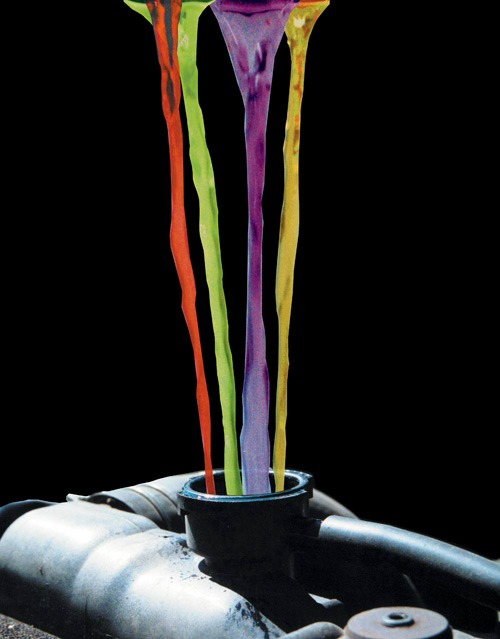 The color of antifreeze is generated completely by coloring dye, not as a direct result of any chemicals mixed during manufacturing. That said, different colors for antifreeze do exist. While specific colors agreed upon in the automotive industry do signify chemical makeup, variations still exist within each shade. The main antifreeze colors you’ll run across are traditional green, extended-life yellow, and extended-life pink or orange. In more recent years, some Korean automakers have even been using blue dye antifreeze.
The color of antifreeze is generated completely by coloring dye, not as a direct result of any chemicals mixed during manufacturing. That said, different colors for antifreeze do exist. While specific colors agreed upon in the automotive industry do signify chemical makeup, variations still exist within each shade. The main antifreeze colors you’ll run across are traditional green, extended-life yellow, and extended-life pink or orange. In more recent years, some Korean automakers have even been using blue dye antifreeze.
Whatever color and type of antifreeze your vehicle was equipped with from the factory, professional technicians as a whole recommend strictly following your manufacturer’s recommendations when it comes to adding new coolant to your system. In other words, use only what your vehicle was built with, and never mix antifreeze types. Some recently developed anti-freezes sold on the market claim to be universal for all vehicles, but we would avoid anything making such a claim.
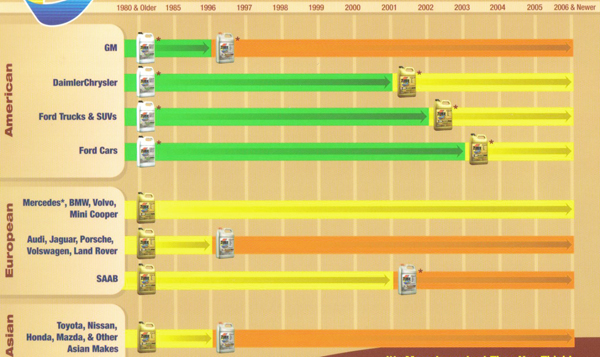
This chart serves as a quick-reference guide to the colors of antifreeze used by various automakers over the years.
Green Antifreeze
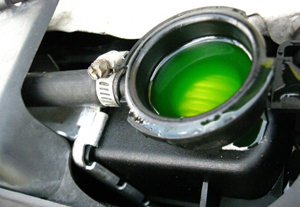 For many decades, virtually all anti-freeze was died florescent green and made of ethylene glycol. This type of traditional antifreeze uses “Inorganic Acid Technology” (IAT) as a chemical basis, contains either EG or PG, and usually contains silicate or phosphate additives to prevent corrosion of metal cooling system components. Because corrosion-inhibitors in traditional green antifreeze break down sooner, its useful lifespan is shorter – usually rated at three years or 36,000 miles. American conventional green coolants use doses of both silicates and phosphates.
For many decades, virtually all anti-freeze was died florescent green and made of ethylene glycol. This type of traditional antifreeze uses “Inorganic Acid Technology” (IAT) as a chemical basis, contains either EG or PG, and usually contains silicate or phosphate additives to prevent corrosion of metal cooling system components. Because corrosion-inhibitors in traditional green antifreeze break down sooner, its useful lifespan is shorter – usually rated at three years or 36,000 miles. American conventional green coolants use doses of both silicates and phosphates.
However, conventional green antifreeze added to most Japanese cars at the factory does not contain any silicates. Instead, they use phosphates because of their fast-acting protection of aluminum, and they use other inhibitors. Phosphates react very poorly if hardened mineral water is used in the cooling system rather than distilled water.
Orange & Pink Antifreeze – Organic Acid Technology (OAT) type coolants
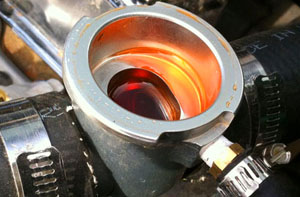 Antifreezes died pink or orange have been around since 1996 and feature a newer class of corrosion-preventing inhibitors known as organic acids. They do not contain silicates or phosphates found in abundance in traditional green American coolant.
Antifreezes died pink or orange have been around since 1996 and feature a newer class of corrosion-preventing inhibitors known as organic acids. They do not contain silicates or phosphates found in abundance in traditional green American coolant.
These Organic Acid Technology (OAT) type coolants were widely used in Europe before being introduced to the American market, and they typically have a longer service life of 5 years or 150,000 miles because these inhibitors last longer before breaking down. Examples of brands available in the United States with these organic acids are Havoline Dex-Cool and Prestone Extended Life. It’s important to note that organic acid antifreezes should never be used on older vehicles that have a traditional copper-and-brass radiator, only aluminum or plastic ones.
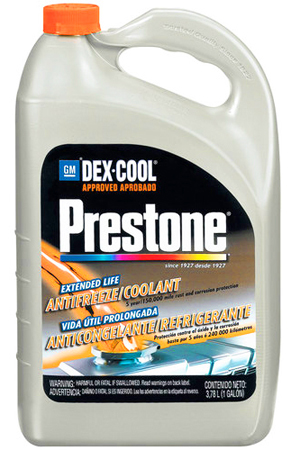
“DexCool” is the marketing name most often used for the type of extended-life orange coolant developed by General Motors. Many companies sell GM-approved DexCool antifreezes, as shown here.
Variations of this coolant type are used General Motors along with some European and Asian manufacturers (see chart further above). Recently, Honda and Toyota have also begun using extended-life OAT coolants, and some Toyotas are equipped with coolant that’s dyed red. Because of past problems with Dextron developing a rusty sludge if coolant level was chronically low, both companies insist that Dextron antifreeze not be used in their cooling systems.
General Motors Dextron and other approved “Dex-cool” coolants that are similar use organic inhibitors named sebacate and 2-EHA (2-ethylhexanoic acid) that are tailored for cast iron engine blocks which GM used in abundance. Although those organic acids used in Dextron are stable for the long term and can handle hard mineral water, they have been found to have a number of issues. 2-EHA doesn’t become fully protective until thousands of miles have passed, and it can soften plastic which can cause gaskets to leak.
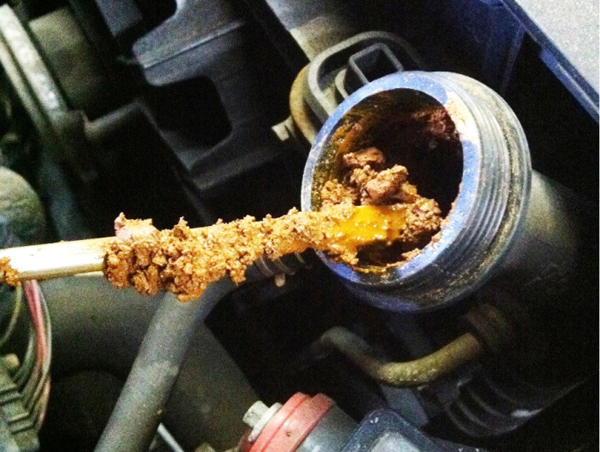
Class action lawsuits have been brought against General Motors for damage done to owners’ vehicles when Dextron coolant turned into rusty sludge and did not provide protection as promised. Today, most Japanese automakers use a variation of orange coolant, but forbid the use of Dextron in their vehicles.
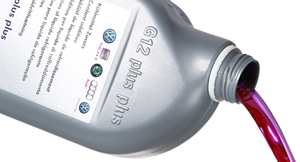 Other manufacturers such as Chrysler and Mercury have dabbled with similar types of orange coolant blends on some models in the past, but have not committed to it on a large scale. Volkswagen, Audi, and other VW-owned marques use variations of their own mix named “G-12” that’s died pink.
Other manufacturers such as Chrysler and Mercury have dabbled with similar types of orange coolant blends on some models in the past, but have not committed to it on a large scale. Volkswagen, Audi, and other VW-owned marques use variations of their own mix named “G-12” that’s died pink.
Light Yellow Antifreeze – Hybrid Organic Acid Technology (HOAT) type coolants
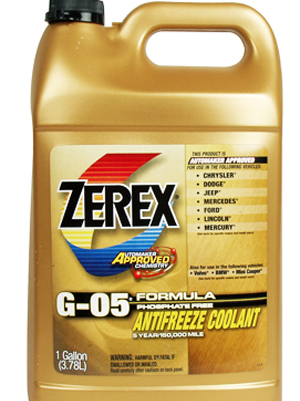 Coolant dyed a very light yellow is known as “G-5”. Developed by German corporation BASF and originally designated Glysantin G05, it gained popularity with European automakers as well as Chrysler and Ford after Mercedes-Benz began using it in 1984. Valvoline is currently licensed to use the BASF formulation, and their similar version that’s approved by Mercedes and other vehicle makes is most commonly sold under the “Zerex” brand name.
Coolant dyed a very light yellow is known as “G-5”. Developed by German corporation BASF and originally designated Glysantin G05, it gained popularity with European automakers as well as Chrysler and Ford after Mercedes-Benz began using it in 1984. Valvoline is currently licensed to use the BASF formulation, and their similar version that’s approved by Mercedes and other vehicle makes is most commonly sold under the “Zerex” brand name.
While HOAT coolants typically mix an OAT with a traditional inhibitor such as silicates or phosphates, G05 is a low-silicate, phosphate-free formula blended with a benzoic acid inhibitor.
MIXING COOLANT TYPES TOGETHER CAN BE HARMFUL TO YOUR SYSTEM – ADD PURE WATER IN AN EMERGENCY
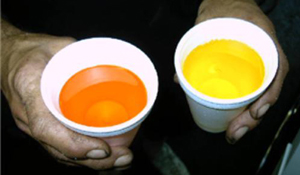 Combining any of the anti-freezes discussed above is not recommended. If you’re in an emergency situation where coolant level is low because of a leak, you’re far better off adding pure water than a different type of antifreeze. If you’ve mixed different colors by accident, have your entire cooling system flushed out professionally as soon as possible.
Combining any of the anti-freezes discussed above is not recommended. If you’re in an emergency situation where coolant level is low because of a leak, you’re far better off adding pure water than a different type of antifreeze. If you’ve mixed different colors by accident, have your entire cooling system flushed out professionally as soon as possible.
At best, mixing types of antifreeze will cause the lifespan of the new mixture to degrade to that of the one with the shorter service interval. At worst, different corrosion inhibitors that were never designed to mix will work against each other – damaging your vehicle’s cooling system in the process.
For example, mixing green coolant with orange or pink antifreeze will cause the resultant mixture to gel into a thicker substance which doesn’t flow as easily – clogging cooling system channels, radiators, and heater cores. Left uncorrected, the water pump will overheat and fail. Should the engine itself become majorly overheated, there’s a good chance head gasket seals will blow and cylinder heads will become permanently warped.
COOLANT ADDITIVES
Powerful, high-horsepower engines generate a great deal of heat, so it’s not uncommon for under hood temperatures to reach higher levels. For this type of performance, coolant additives contain agents that reduce air bubbles and air pockets which create “hot spots”. As a result, there’s more complete coolant contact with all internal engine and radiator surfaces – resulting in a cooler running engine without heat transference being compromised. Corrosion inhibitors contained within the additives also replace inhibitors lost naturally over time – fortifying your system further against rust and sludge buildup.

































